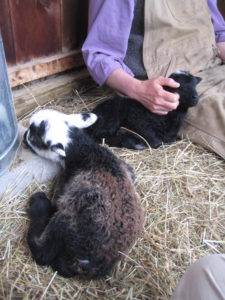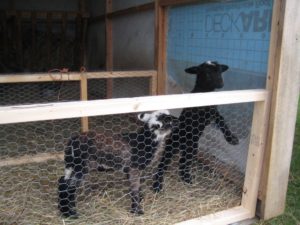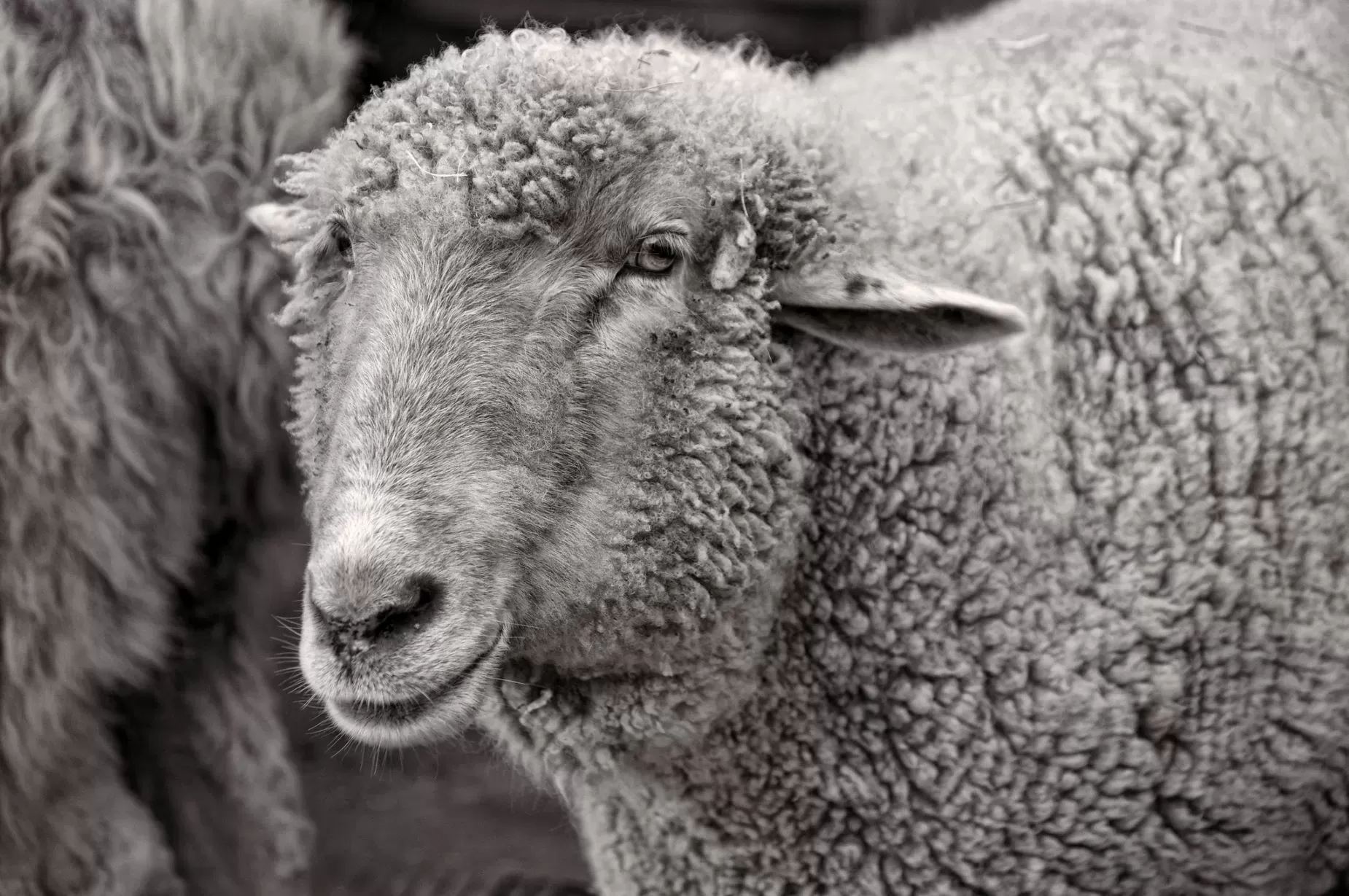Crescent was getting more than a bit familiar with me. First it was my fingers, then the seams and zipper pulls on my hiking pants. Increasingly desperate, she started nibbling hard enough that she nipped the flesh beneath my pants, including my inner thigh. I couldn’t stop laughing as she got frisky. Sitting on the wood floor of the greenhouse, we were also terrified we wouldn’t be able to keep beautiful Crescent and her adorable twin Joseph alive.
June Bug (Junie for short) had given birth and licked her gooey lambs clean as faint pink barely warmed the horizon. After getting off to a good start, Junie then rejected her very first lambs. When my husband found Crescent and Joseph, they were cowering in an empty corner of the ramshackle compost bin, trying to keep Junie—their mother—from headbutting them. No wonder my husband rises early during lambing season. Worry awakens him before the stars have entirely faded from the night sky.

Farming and homesteading came later in life for both of us. I never did 4-H, rode horses, or raised chickens or rabbits as a kid, but Laura Ingalls Wilder’s books on my childhood bookshelves were stained and dog-eared. I binge read before binge watching was a thing.
I only became a farmer at 40. I truly became a farmer—and shepherdess—two years later when we brought home six Navajo-Churro sheep, including Junie, then only a month old, on a muggy afternoon in late July. Churro are tough, hardy sheep. Spanish colonizers brought domesticated Churra sheep, an ancient Iberian breed, to the so-called New World. They grazed, moved, and ate the sheep, but some escaped or were traded with local indigenous peoples. The Diné (Navajo) in what became the U.S. Southwest adopted the Churro into their livelihoods, lifeways, and cosmology, rewriting them into origin stories. As they say, “Sheep Is Life.”
Churro are scrappy, adaptable sheep, navigating the land, droughts, and arid and semi-arid vegetation of the American Southwest—or the rich pastures of upstate New York. Unlike many sheep breeds, Churro were not overbred for specific traits that might have yielded softer wool, faster maturation, or higher rates of triplets, but resulted in many other problems. The ewes are also known as good moms. Apparently, Junie didn’t get that memo.
Becoming a homesteader and shepherdess has made it easier to confront death—an especially important lesson in midlife. There is no other choice.
Life and death are inescapable on the farm, entangled, spiraling endlessly like the staircases in an Escher painting. Seeds germinate, starts grow. Except germination can be poor and seedlings die or get eaten by the many eager nonhumans wanting lunch. Dead plants, along with kitchen scraps, weeds, and poopy hay from the sheep shack and chicken coop end up in the compost pile. Several seasons later, the rich, black soil that smells musky and tickles my nose brings new seeds and starts to life.
We raise chicks the old-fashioned way—by broody hens. Usually on day 20 of the 21-day gestation period, hens start wriggling and giving quizzical looks. The next day, we find empty shells, fuzzy puff balls, and mother hens teaching them how to be chickens. Except some chicks never make it out of the shell, die trying, or don’t survive for more than a few minutes or hours. Sometimes other chickens kill them. Then there are the racoons, foxes, and hawks who, like humans, like chicken dinners.
When we got sheep, we invested in several hundred meters of mobile electric fencing and electrified the rusty perimeter fence of the former horse pasture. Still, a coyote or several coyotes got in and attacked Joseph when he was three months old. He made it—again—but Diego the llama joined the farm family to protect the sheep. His sheep. And protect he did, with particularly loving care of the new lambs born the following spring. Until Diego died, most likely from a tragic combination of parasites and hypothermia, shortly before Christmas. His bleached bones slowly deteriorate in the forest, surrounded by lush, verdant grass and shrubs reaching for dappled sunlight amid the trees. Grazing the sheep in our small forest has helped bring the woods back to life.

In the greenhouse-now-abandoned-lamb-station, we had to set aside panic to figure out how to keep those two beautiful lambs alive that crisp spring morning. Enclosed in a small catch pen, Crescent and Joseph struggled to nurse as new ewe-mom June Bug kept wandering off or accidentally kicking them. The farm animal division of Cornell Vet promised to call us back. Meanwhile, I made a run into town to the local Agway for rubber nipples and turned rinsed-out beer bottles into lamb bottles. No luck. With four arms between us, we wrestled Junie and her two, hours-old lambs, coaxing Crescent and Joseph to nurse, trying to get June Bug to cooperate. Still no luck. More calls to Cornell Vet. Fatty brown adipose tissue can keep lambs alive for a day or so without nursing. But as the hours passed, we worried. As more hours passed, we worried more and more.
“Get them on the teats!” insisted the veterinarian, not impressed with our gentle, naïve tactics. “Flip the mom on her butt and get the lambs on them!”
Finally, tails wagging furiously and the sound of slurpy suckling. We exhaled.
We were now, unexpectedly, key members of a multispecies, co-parenting family: one ewe, twin lambs, and two humans. As with human babies, my husband was up every few hours throughout the night—11 pm, 2 am, 4 am—getting the lambs “on the teats.” With a more than full-time job, I got a pass on night shifts. Crescent and Joseph baaed and ran around in circles as soon as my husband emerged from our house, knowing they would soon get to nurse. Junie was not thrilled with the arrangement but put up with it. Finally, after a week, the little sheep family was on their own in a small pasture working out a reasonable agreement. Regular nursing, minimal attention or affection from mom. Delicious, life-sustaining milk, more attention and affection from the humans.
At the time, we were confident Crescent and Joseph would make it after that terrifying first week. Turns out a week or two may not be enough. Sweet lamb Mateo died suddenly on day 11 of his short life. Healthy, asking for pets, rubbing our farm boots like a cat one evening to limp in the pasture of a dozen shades of green the next afternoon. Older sheep are not immune either. Of the original six sheep, our favorite, Spot, also died suddenly, choking on alfalfa pellets intended to nourish her through her first pregnancy.
Even that very evening after losing Mateo, we consoled ourselves by watching the other lambs frolic. Dusk is prime time for what we call “Lambie TV.” They run and chase, boing and pronk, prance and bounce until their sides heave and mouths hang open. Their rambunctious antics suggest they are so happy to be alive. It’s hard to be sad watching lambs, even though we were bereft because one of them had died unexpectedly. The logic makes no sense and, somehow, perfect sense.
Being a farmer and shepherdess over these past few years helped prepare me for my mother’s death. My students gave presentations based on their final papers the afternoon Mateo died in my husband’s arms. My department chair had told me I could cancel the presentations, but I wanted to teach and see my students in person one last time. It was also a break from long hours at the hospice residence where I held vigil mostly alone. When I got home from work that afternoon, Mateo’s mom was baaing loudly, plaintively. His twin sister was glued to her side as she wandered and bellowed, looking, looking. I didn’t see Mateo either. Then my husband told me.
Americans are not good at dying, death, and grief. Optimistic platitudes rub like salt in wounds. “I’m sorry for your loss, but she’s in a better place!” “Her death is a blessing.” Forgetting what happened immediately after sending the perfunctory pastel-colored card with formulaic condolences printed in italicized font is worse. However, silence is still worse. In the United States, bereavement is supposed to be compartmentalized into two neat and tidy weeks, if one is so fortunate to have job flexibility and financial resources to permit such grief-in-a-box. Thank you, capitalism.
Death is inevitable on the farm—not if, but when, how, and who (for most people, though not us, what). It doesn’t mean it’s easy to watch. It’s harder when death comes at our hands to end an animal’s suffering or put delicious meat in the freezer, which is forever “his” or “hers,” not “the” or “its”; as in, “her sausage is delicious.” Crescent and Joseph survived their hard landing into a harsh world. Death was not their fate that spring day. Indeed, Crescent is now a two-time ewe-mom. Her lambs romp joyfully through the pasture as I type. But death will come. For all of them. For all of us.
When I spoke with each hospice nurse for the first time, I told them I always wanted their frank assessment. “My philosophy is eyes wide open. I need to know what I’m facing. I want to know what I’m facing.”
When my doctor asked how I was doing, I told her that I am mostly okay. Given her dementia, I had been grieving for five years before my mother actually passed. Few people ever acknowledged this. My therapist explained that it’s called “ambiguous” and “disenfranchised” grief.
The low days, though, are very, very low. It’s hard watching someone die. It’s harder watching someone die for the first time. It is even harder when that person is your mom.
My doctor shook her head in sympathy. “Dying and death are often hidden in American culture. It doesn’t help anyone going through it.”
“Strangely, being a farmer helps.” She paused, cocked her head, and then began nodding slowly. “I can see that.”
Animals are not humans, Mateo was not my mom. But Crescent, Joseph, Diego, Spot, and Mateo taught me to confront death, its possibility, and its inevitability. With eyes wide open.
![]()
Find out more about Sara on our Contributors’ Page.
(Photo: Don DeBold/flickr.com/CC-BY SA 2.0)
- Eyes Wide Open, by Sara B. Pritchard - August 18, 2022

